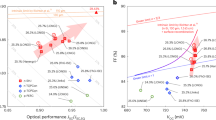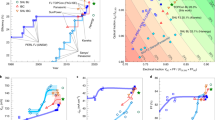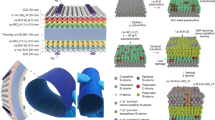Abstract
The nanostructuring of silicon surfaces—known as black silicon—is a promising approach to eliminate front-surface reflection in photovoltaic devices without the need for a conventional antireflection coating. This might lead to both an increase in efficiency and a reduction in the manufacturing costs of solar cells. However, all previous attempts to integrate black silicon into solar cells have resulted in cell efficiencies well below 20% due to the increased charge carrier recombination at the nanostructured surface. Here, we show that a conformal alumina film can solve the issue of surface recombination in black silicon solar cells by providing excellent chemical and electrical passivation. We demonstrate that efficiencies above 22% can be reached, even in thick interdigitated back-contacted cells, where carrier transport is very sensitive to front surface passivation. This means that the surface recombination issue has truly been solved and black silicon solar cells have real potential for industrial production. Furthermore, we show that the use of black silicon can result in a 3% increase in daily energy production when compared with a reference cell with the same efficiency, due to its better angular acceptance.
This is a preview of subscription content, access via your institution
Access options
Subscribe to this journal
Receive 12 print issues and online access
$259.00 per year
only $21.58 per issue
Buy this article
- Purchase on Springer Link
- Instant access to full article PDF
Prices may be subject to local taxes which are calculated during checkout





Similar content being viewed by others
References
Clapham, P. B. & Hutley, M. C. Reduction of lens reflection by the ‘moth eye’ principle. Nature 3, 281–282 (1973).
Zhu, J. et al. Optical absorption enhancement in amorphous silicon nanowire and nanocone arrays. Nano Lett. 9, 279 (2008).
Garnett, E. & Yang, P. Light trapping in silicon nanowire solar cells. Nano Lett. 10, 1082–1087 (2010).
Kelzenberg, M. D. et al. Enhanced absorption and carrier collection in Si wire arrays for photovoltaic applications. Nature Mater. 9, 239–244 (2010).
Oh, J., Yuan, H-C. & Branz, H. M. An 18.2%-efficient black-silicon solar cell achieved through control of carrier recombination in nanostructures. Nature Nanotech. 7, 743–748 (2012).
Zhu, J., Hsu, C-M., Yu, Z., Fan, S. & Cui, Y. Nanodome solar cells with efficient light management and self-cleaning. Nano Lett. 10, 1979–1984 (2010).
De Boer, M. J. et al. Guidelines for etching silicon MEMS structures using fluorine high-density plasmas at cryogenic temperatures. J. Micromech. Microeng. 11, 385–401 (2002).
Gesemann, B., Wehrspohn, R., Hackner, A. & Müller, G. Large-scale fabrication of ordered silicon nanotip arrays used for gas ionization in ion mobility spectrometers. IEEE Trans. Nanotechnol. 10, 50–52 (2011).
Hoyer, P., Theuer, M., Beigang, R. & Kley, E-B. Terahertz emission from black silicon. Appl. Phys. Lett. 93, 091106 (2008).
Sainiemi, L. et al. Rapid fabrication of high aspect ratio silicon nanopillars for chemical analysis. Nanotechnology 18, 505303 (2007).
Huang, Z. et al. Microstructured silicon photodetector. Appl. Phys. Lett. 89, 033506 (2006).
Ivanova, E. P. et al. Bactericidal activity of black silicon. Nature Commun. 4, 2838 (2013).
Jeong, S., McGehee, M. D. & Cui, Y. All-back-contact ultra-thin silicon nanocone solar cells with 13.7% power conversion efficiency. Nature Commun. 4, 2950 (2013).
Zhong, S. et al. Influence of the texturing structure on the properties of black silicon solar cell. Sol. Energ. Mater. Sol. Cells 108, 200–204 (2013).
Koynov, S., Brandt, M. S. & Stutzmann, M. Black multi-crystalline silicon solar cells. Phys. Status Solidi RRL 1, R53–R55 (2007).
Hoex, B., Schmidt, J., Pohl, P., van de Sanden, M. C. M. & Kessels, W. M. M. Silicon surface passivation by atomic layer deposition Al2O3 . J. Appl. Phys. 104, 044903 (2008).
Repo, P. et al. Effective passivation of black silicon surfaces by atomic layer deposition. IEEE J. Photovolt. 3, 90–94 (2013).
Otto, M. et al. Extremely low surface recombination velocities in black silicon passivated by atomic layer deposition. Appl. Phys. Lett. 100, 191603 (2012).
Neuhaus, D. & Münzer, A. Industrial silicon wafer solar cells. Adv. Optoelectron. 2007, 24521 (2007).
Halbwax, M. et al. Micro and nano-structuration of silicon by femtosecond laser: application to silicon photovoltaic cells fabrication. Thin Solid Films 516, 6791–6795 (2008).
Toor, F., Branz, H. M., Page, M. R., Jones, K. M. & Yuan, H-C. Multi-scale surface texture to improve blue response of nanoporous black silicon solar cells. Appl. Phys. Lett. 99, 103501 (2011).
Sainiemi, L. et al. Non-reflecting silicon and polymer surfaces by plasma etching and replication. Adv. Mater. 23, 122–126 (2011).
Huang, Y-F. et al. Improved broadband and quasi-omnidirectional anti-reflection properties with biomimetic silicon nanostructures. Nature Nanotech. 2, 770–774 (2007).
Richter, A., Glunz, S. W., Werner, F., Schmidt, J. & Cuevas, A. Improved quantitative description of Auger recombination in crystalline silicon. Phys. Rev. B 86, 165202 (2012).
Carrio, D. et al. Rear contact optimization based on 3D simulations for IBC solar cells with point-like doped contacts. Energy Procedia 55, 47 (2014).
Hoex, B., van de Sanden, M. C. M., Schmidt, J., Brendel, R. & Kessels, W. M. M. Surface passivation of phosphorus-diffused n+-type emitters by plasma-assisted atomic-layer deposited Al2O3 . Phys. Status Solidi RRL 6, 4–6 (2012).
Masters, G. M. Renewable and Efficient Electric Power Systems (Wiley, 2004).
Acknowledgements
This work was supported by the network ‘Nanophotonics for Energy Efficiency’ (grant agreement no. 248855), the Effinano-project (funded by the School of Electrical Engineering at Aalto University) and the Tekes-funded project PASSI. The authors acknowledge The Centre for Research in NanoEngineering (CRnE) and Aalto University Micronova Nanofabrication Centre for providing facilities. The authors thank T. Trifonov for help and comments on performing reflectance measurements and V. Vähänissi for providing valuable comments regarding writing the manuscript.
Author information
Authors and Affiliations
Contributions
H.S. and R.A. conceived and designed the experiments. P.R., G.G., P.O. and E.C. performed the experiments. P.O. and H.S. analysed the data. M.G. performed the angle-dependent simulations. H.S. wrote the paper. All authors discussed the results and commented on the manuscript.
Corresponding author
Ethics declarations
Competing interests
The authors declare no competing financial interests.
Supplementary information
Supplementary information
Supplementary information (PDF 577 kb)
Rights and permissions
About this article
Cite this article
Savin, H., Repo, P., von Gastrow, G. et al. Black silicon solar cells with interdigitated back-contacts achieve 22.1% efficiency. Nature Nanotech 10, 624–628 (2015). https://doi.org/10.1038/nnano.2015.89
Received:
Accepted:
Published:
Issue Date:
DOI: https://doi.org/10.1038/nnano.2015.89
This article is cited by
-
Role of wet chemical saw damage removal process in texturing of c-Si and performance of a-Si:H/c-Si heterojunction solar cells
Applied Physics A (2023)
-
Nanowire geometry effects on devices and transport mechanisms: SnS2/SiNW heterojunction
Journal of Materials Science (2023)
-
Review on Metallization Approaches for High-Efficiency Silicon Heterojunction Solar Cells
Transactions of Tianjin University (2022)
-
Nanostructure-assisted optical tweezers for microspectroscopic polymer analysis
Polymer Journal (2021)
-
Fabrication of Disordered Nanostructures by Nanosphere Lithography and Its Application for Ultrathin Si Wafers
Journal of Electronic Materials (2021)



